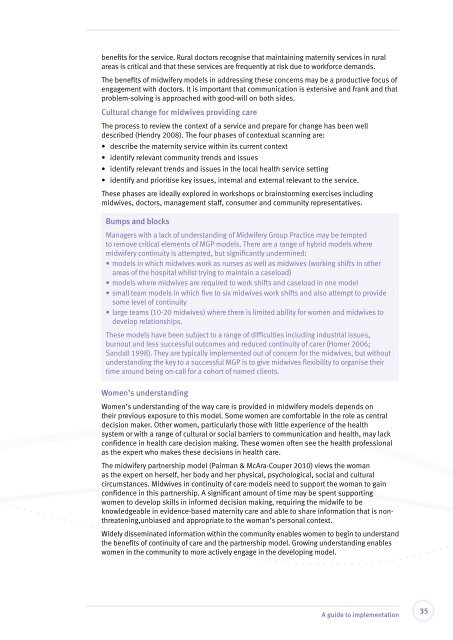Delivering continuity of midwifery care to Queensland women
Delivering continuity of midwifery care to Queensland women
Delivering continuity of midwifery care to Queensland women
Create successful ePaper yourself
Turn your PDF publications into a flip-book with our unique Google optimized e-Paper software.
enefits for the service. Rural doc<strong>to</strong>rs recognise that maintaining maternity services in rural<br />
areas is critical and that these services are frequently at risk due <strong>to</strong> workforce demands.<br />
The benefits <strong>of</strong> <strong>midwifery</strong> models in addressing these concerns may be a productive focus <strong>of</strong><br />
engagement with doc<strong>to</strong>rs. It is important that communication is extensive and frank and that<br />
problem-solving is approached with good-will on both sides.<br />
Cultural change for midwives providing <strong>care</strong><br />
The process <strong>to</strong> review the context <strong>of</strong> a service and prepare for change has been well<br />
described (Hendry 2008). The four phases <strong>of</strong> contextual scanning are:<br />
• describe the maternity service within its current context<br />
• identify relevant community trends and issues<br />
• identify relevant trends and issues in the local health service setting<br />
• identify and prioritise key issues, internal and external relevant <strong>to</strong> the service.<br />
These phases are ideally explored in workshops or brains<strong>to</strong>rming exercises including<br />
midwives, doc<strong>to</strong>rs, management staff, consumer and community representatives.<br />
Bumps and blocks<br />
Managers with a lack <strong>of</strong> understanding <strong>of</strong> Midwifery Group Practice may be tempted<br />
<strong>to</strong> remove critical elements <strong>of</strong> MGP models. There are a range <strong>of</strong> hybrid models where<br />
<strong>midwifery</strong> <strong>continuity</strong> is attempted, but significantly undermined:<br />
• models in which midwives work as nurses as well as midwives (working shifts in other<br />
areas <strong>of</strong> the hospital whilst trying <strong>to</strong> maintain a caseload)<br />
• models where midwives are required <strong>to</strong> work shifts and caseload in one model<br />
• small team models in which five <strong>to</strong> six midwives work shifts and also attempt <strong>to</strong> provide<br />
some level <strong>of</strong> <strong>continuity</strong><br />
• large teams (10-20 midwives) where there is limited ability for <strong>women</strong> and midwives <strong>to</strong><br />
develop relationships.<br />
These models have been subject <strong>to</strong> a range <strong>of</strong> difficulties including industrial issues,<br />
burnout and less successful outcomes and reduced <strong>continuity</strong> <strong>of</strong> <strong>care</strong>r (Homer 2006;<br />
Sandall 1998). They are typically implemented out <strong>of</strong> concern for the midwives, but without<br />
understanding the key <strong>to</strong> a successful MGP is <strong>to</strong> give midwives flexibility <strong>to</strong> organise their<br />
time around being on-call for a cohort <strong>of</strong> named clients.<br />
Women’s understanding<br />
Women’s understanding <strong>of</strong> the way <strong>care</strong> is provided in <strong>midwifery</strong> models depends on<br />
their previous exposure <strong>to</strong> this model. Some <strong>women</strong> are comfortable in the role as central<br />
decision maker. Other <strong>women</strong>, particularly those with little experience <strong>of</strong> the health<br />
system or with a range <strong>of</strong> cultural or social barriers <strong>to</strong> communication and health, may lack<br />
confidence in health <strong>care</strong> decision making. These <strong>women</strong> <strong>of</strong>ten see the health pr<strong>of</strong>essional<br />
as the expert who makes these decisions in health <strong>care</strong>.<br />
The <strong>midwifery</strong> partnership model (Pairman & McAra-Couper 2010) views the woman<br />
as the expert on herself, her body and her physical, psychological, social and cultural<br />
circumstances. Midwives in <strong>continuity</strong> <strong>of</strong> <strong>care</strong> models need <strong>to</strong> support the woman <strong>to</strong> gain<br />
confidence in this partnership. A significant amount <strong>of</strong> time may be spent supporting<br />
<strong>women</strong> <strong>to</strong> develop skills in informed decision making, requiring the midwife <strong>to</strong> be<br />
knowledgeable in evidence-based maternity <strong>care</strong> and able <strong>to</strong> share information that is nonthreatening,unbiased<br />
and appropriate <strong>to</strong> the woman’s personal context.<br />
Widely disseminated information within the community enables <strong>women</strong> <strong>to</strong> begin <strong>to</strong> understand<br />
the benefits <strong>of</strong> <strong>continuity</strong> <strong>of</strong> <strong>care</strong> and the partnership model. Growing understanding enables<br />
<strong>women</strong> in the community <strong>to</strong> more actively engage in the developing model.<br />
A guide <strong>to</strong> implementation<br />
35
















